| INDEX
Home
Weapons
Photo Galleries
News
Humor
Pages
New
Stuff
Contact Me
|
John Kerry's
Political Friends
Kerry's Vietnam Veterans Against The War planned
assassination plot against U.S. Congressmen and Senators
By Thomas H. Lipscomb
The New York Sun
March 15, 2004
|
 The
anti-war group that John Kerry was the principal
spokesman for debated and voted on a plot to assassinate
politicians who supported the Vietnam War. The
anti-war group that John Kerry was the principal
spokesman for debated and voted on a plot to assassinate
politicians who supported the Vietnam War.
Mr. Kerry denies being present at the November 12-15,
1971, meeting in Kansas City of Vietnam Veterans Against
the War, and says he quit the group before the meeting.
But according to the current head of Missouri Veterans
for Kerry, Randy Barnes, Mr. Kerry, who was then 27,was
at the meeting, voted against the plot, and then orally
resigned from the organization.
Mr. Barnes was present as part of the Kansas City host
chapter for the 1971 meeting and recounted the incident
in a phone interview with The New York Sun this week.
In addition to Mr. Barnes’s recollection placing Mr.
Kerry at the Kansas City meeting, another Vietnam
veteran who attended the meeting, Terry Du-Bose, said
that Mr. Kerry was there.
There are at least two other independent corroborations
that the antiwar group Vietnam Veterans Against the War,
of which Mr. Kerry was the most prominent national
spokesman, considered assassinating American political
leaders who favored the war.
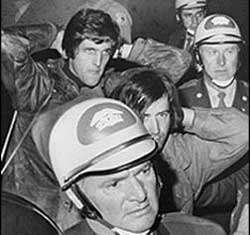 Gerald
Nicosia’s 2001 book Home To War reports that
one of the key leaders of Vietnam Veterans Against the
War, Scott Camil, “proposed the assassination of the
most hard-core conservative members of Congress, as well
as any other powerful, intractable opponents of the
antiwar movement.” The book reports on the Kansas City
meeting at which Mr. Camil’s plan was debated and then
voted down. Gerald
Nicosia’s 2001 book Home To War reports that
one of the key leaders of Vietnam Veterans Against the
War, Scott Camil, “proposed the assassination of the
most hard-core conservative members of Congress, as well
as any other powerful, intractable opponents of the
antiwar movement.” The book reports on the Kansas City
meeting at which Mr. Camil’s plan was debated and then
voted down.
Mr. Nicosia’s book was widely praised by reviewers as
varied as General Harold Moore, author of We Were
Soldiers; Gloria Emerson, who had been a New
York Times reporter during the Vietnam War, and
leftist Howard Zinn. Mr. Kerry himself stated in a blurb
on the cover that the book “ties together the many
threads of a difficult period.” Mr. Kerry hosted a party
for the book in the Hart Senate Office Building that was
televised on C-SPAN.
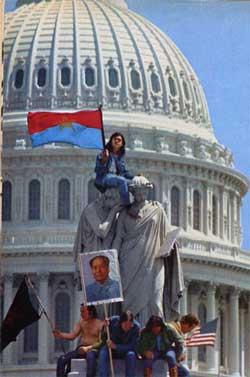 Another
source is an October 20,1992, oral history interview of
Scott Camil on file at the University of Florida Oral
History Archive. In it, Mr. Camil speaks of his plan for
an alternative to Mr. Kerry’s idea of symbolically
throwing veterans’ medals over the fence onto the steps
of the Capitol during the Dewey Canyon III demonstration
in Washington in April of 1971. Another
source is an October 20,1992, oral history interview of
Scott Camil on file at the University of Florida Oral
History Archive. In it, Mr. Camil speaks of his plan for
an alternative to Mr. Kerry’s idea of symbolically
throwing veterans’ medals over the fence onto the steps
of the Capitol during the Dewey Canyon III demonstration
in Washington in April of 1971.
“My plan was that, on the last day we would go into the
[congressional] offices we would schedule the most
hardcore hawks for last and we would shoot them all,”
Mr. Camil told the Oral History interviewer. “I was
serious.”
In a phone interview with the Sun this week, Mr. Camil
did not dispute either the account in the Nicosia book
or in the oral history. He said he plans to accept an
offer by the Florida Kerry organization to become active
in Mr. Kerry’s presidential campaign. Campaign aides to
Mr. Kerry invited Mr. Camil to a meeting for the senator
in Orlando last week, but they did not meet directly.
Mr. Camil was known to colleagues in the anti-war
movement as “Scott the Assassin.” Mr. Camil told The
New York Sun he got the name in Vietnam for
“sneaking down to the Vietnamese villages at night and
killing people.”
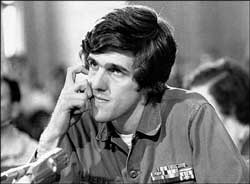 According
to the Nicosia book and interviews with VVAW members who
were involved, at the Vietnam Veterans Against the War
Kansas City leadership conference, Mr. Camil tried to
put his plan into effect. He called together eight to 10
Marines to organize something he called “The Phoenix
Project.” The original Phoenix Project during the
Vietnam War was an attempt to destroy the Viet Cong
leadership by assassination. Mr. Camil’s Phoenix Project
planned to execute the Southern senatorial leadership
that was financing the Vietnam War. Senators like John
Stennis, Strom Thurmond, and John Tower were his
targets, according to Mr. Camil. They were to be killed
during the Senate Christmas recess the following month. According
to the Nicosia book and interviews with VVAW members who
were involved, at the Vietnam Veterans Against the War
Kansas City leadership conference, Mr. Camil tried to
put his plan into effect. He called together eight to 10
Marines to organize something he called “The Phoenix
Project.” The original Phoenix Project during the
Vietnam War was an attempt to destroy the Viet Cong
leadership by assassination. Mr. Camil’s Phoenix Project
planned to execute the Southern senatorial leadership
that was financing the Vietnam War. Senators like John
Stennis, Strom Thurmond, and John Tower were his
targets, according to Mr. Camil. They were to be killed
during the Senate Christmas recess the following month.
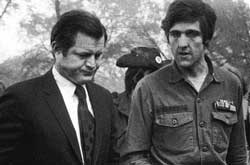 After
an attempt to parcel out the hit jobs required to kill
the senators, Mr. Camil’s plan was presented to all the
chapter coordinators present and the VVAW leadership.
Mr. Nicosia’s book recounts, “What Camil sketched was so
explosive that the coordinators feared lest government
agents even hear of it. So they decamped to a church on
the outskirts of town with the intention of debating the
plan in complete privacy. When they got to the church,
however, they found that the government was already on
to them; their ‘debugging expert’ uncovered microphones
hidden all over the place. An instantaneous decision was
made to move again to Common Ground, a Mennonite hall
used by homeless vets as a ‘crash pad.’” After
an attempt to parcel out the hit jobs required to kill
the senators, Mr. Camil’s plan was presented to all the
chapter coordinators present and the VVAW leadership.
Mr. Nicosia’s book recounts, “What Camil sketched was so
explosive that the coordinators feared lest government
agents even hear of it. So they decamped to a church on
the outskirts of town with the intention of debating the
plan in complete privacy. When they got to the church,
however, they found that the government was already on
to them; their ‘debugging expert’ uncovered microphones
hidden all over the place. An instantaneous decision was
made to move again to Common Ground, a Mennonite hall
used by homeless vets as a ‘crash pad.’”
“Camil was deadly serious, brilliant, and highly
logical,” Mr. Nicosia told the Sun.
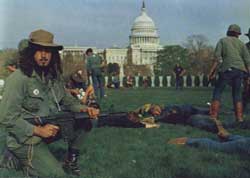 The
plan was voted down. There’s a difference of opinion as
to how narrow the margin was. The
plan was voted down. There’s a difference of opinion as
to how narrow the margin was.
The claims of Mr. Kerry’s involvement in the
assassination discussions in Kansas City have apparently
not been previously reported.
The most recent book that focuses on Mr. Kerry’s
relations with his fellow Vietnam veterans, Douglas
Brinkley’s Tour of Duty, reports the events as
follows: “In a November 10 letter housed at the VVAW
papers in Madison, Wisconsin, Kerry quit, politely
noting he had been proud to serve in the national
organization. His reason was straightforward:
‘personality conflicts and differences in political
philosophy.’ In two days,V VAW was meeting in Kansas
City and he would be a no-show.”
But in a footnote, Mr. Brinkley acknowledges, “I could
not locate Kerry’s November 10 VVAW resignation letter
supposedly housed at the Wisconsin archives. The quote I
used comes directly from Andrew E. Hunt’s essential
The Turning: A History of Vietnam Veterans Against the
War (1999).”
When asked by the Sun who told him Mr. Kerry was
“no-show” at Kansas City, Mr. Brinkley replied, “Senator
Kerry.” Mr. Brinkley also stated that Mr. Kerry did not
have a personal copy of the resignation letter either.
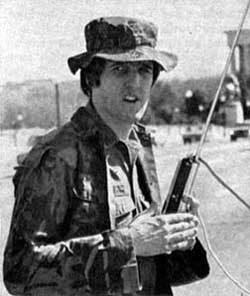 But
in an interview with the Sun, the “essential”
historian Mr. Brinkley relied on as his source, Andrew
E. Hunt, said “I never stated that there was a letter of
resignation, or even implied in my book that I saw one.
I never could find one in the archives in Wisconsin. I
don’t know how Brinkley got the idea that I had. I never
could figure out when Kerry resigned.” When asked about
Mr. Brinkley’s statement that Mr. Kerry didn’t have a
copy of the resignation letter either, Mr. Hunt said, “I
don’t know about that. I never could get an interview
with Senator Kerry. But I never saw anyone who saves
things the way Kerry does.” But
in an interview with the Sun, the “essential”
historian Mr. Brinkley relied on as his source, Andrew
E. Hunt, said “I never stated that there was a letter of
resignation, or even implied in my book that I saw one.
I never could find one in the archives in Wisconsin. I
don’t know how Brinkley got the idea that I had. I never
could figure out when Kerry resigned.” When asked about
Mr. Brinkley’s statement that Mr. Kerry didn’t have a
copy of the resignation letter either, Mr. Hunt said, “I
don’t know about that. I never could get an interview
with Senator Kerry. But I never saw anyone who saves
things the way Kerry does.”
Whether or not there was a letter of resignation dated
November 10 is obviously important, since it predates
the Kansas City assassination discussions by two days.
Mr. Camil said he did not recall whether Mr. Kerry was
at the Kansas City meeting nor did he recall whether he
had discussed his assassination plan with Mr. Kerry.
But Mr. Barnes, the head of the Missouri Veterans for
Kerry, said, “I don’t think there was a letter of
resignation. He just said he was resigning after the
vote.”
Clearly there is considerable confusion about the time
of Mr. Kerry’s resignation. According to Mr. Nicosia,“H
e resigned from the executive committee” after a
spectacular argument with VVAW leader Al Hubbard at the
July national leadership meeting in St Louis.
But on behalf of the John Kerry campaign, spokesman
David Wade told the Sun yesterday that Mr. Kerry
resigned from Vietnam Veterans Against the War “sometime
in the summer of 1971 after the August meeting in St.
Louis, which Kerry did not attend.”
Mr.Wade also said,“Kerry was not at the Kansas City
meeting.”
Two-thirds of the American troops in Vietnam at the
height of American commitment in 1969 had already been
withdrawn in the “Vietnamization” policy in effect at
the time of the VVAW Kansas City conference in November
1971. When asked recently by the Sun why the
assassinations still seemed necessary, Mr. Camil
replied: “The war was still going on. We had to stop
it.”
|
|